During the late 19th century, Newport, Rhode Island, became THE place for American high society to be and be seen while escaping the summer heat. Their epic parties ended over a century ago, but many of the palatial summer “cottages” were saved from the wrecking ball thanks to The Preservation Society of Newport County. Visit and step back in time for a taste of the lifestyles of the Gilded Age rich and famous.
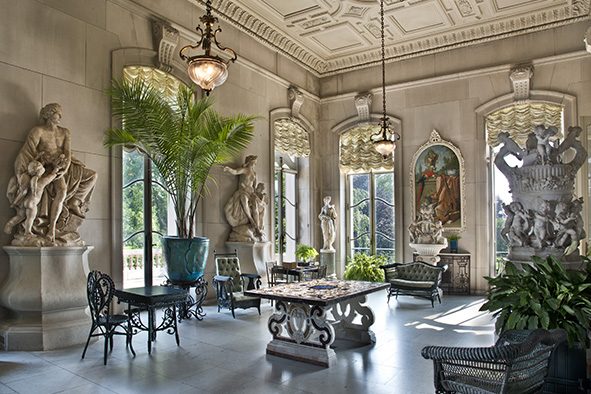
The Elms Conservatory (Photo: Gavin Ashworth/The Preservation Society of Newport County)
Our tour guide paused in front of a small card table. Unlike almost everything else within the summer “cottages” along Bellevue Avenue, the table was not gilded. Nor was it constructed by hand in Paris then shipped by steamboat to be reconstructed within the walls of The Elms Conservatory, where we stood staring at where the former owner, Julia Berwind, had played daily games of bridge and mahjong with her friends.
From the late 1880s through the turn of the century, the quaint colonial resort town of Newport, Rhode Island, became a high society seaside escape where America’s Industrial Age royalty summered. Not in the original cottages, of course. Tycoons like the Astors and the Vanderbilts began one-upping each other, building palaces suited for European nobility, complemented by the modern technologies of the time: electricity, running water, ice makers, telephones, and in-home intercom systems to call upon their servants.
After the tour ended, Julia Berwind’s humble card table would remain more compelling than the grand dining room, rare Venetian paintings, and even the pillows made from the wedding tent of Marie Antoinette. Maybe the card table stood out because my family too plays games when on vacation. For a flash, Julia had seemed a little like me. Human.
That fleeting moment of connection had quickly passed when our tour guide revealed that on afternoons without visitors, Julia had her butler stand-in: the butler would play cards while standing the entire time. The servants, the butler, the very fact that Julia played games in a named room in a named house highlighted the other-worldly glamour that lures visitors like me to spend a day or few being swept back in time to when we could have been a guest at these palatial summer residences.
Julia was not the original owner of The Elms, but the younger sister of the New York coal tycoon Edward Berwind, whose company produced two-thirds of the world’s coal at the time. After Berwind’s wife Herminie died, he invited his sister to reign as the hostess. Even after her brother passed away, Julia continued to summer at The Elms until she died at the age of 95 in 1961, long after the glamour of the Gilded Age had faded. Mansions down the block had already been bought up for less than pennies on the dollar, reduced to rubble, and re-birthed as shopping centers. All the while, the Berwind heiress had continued playing bridge in her own little gilded bubble.
When we later paused in The Elms ballroom, decorated in the Louis XV style, I could almost hear the bumble and buzz of a live jazz band competing with a chorus of chatter and laughter during one of the owners’ many galas. The first of which was French themed, like the house, complete with live monkeys, a facet the hosts had heard were requisite to Parisian party style. The rowdy creatures had startled the ladies and ran free around town creating fodder to fuel local gossip.
Any time the tour guide’s spiel moved beyond the décor and into the owners’ lives my interest grew. I imagined walking or riding in a buggy down Bellevue and playing ‘who owns what’, just as tourists do nowadays in Beverly Hills, driving slowly down streets shaded by palm trees; guided by maps charting the homes of Hollywood stars.
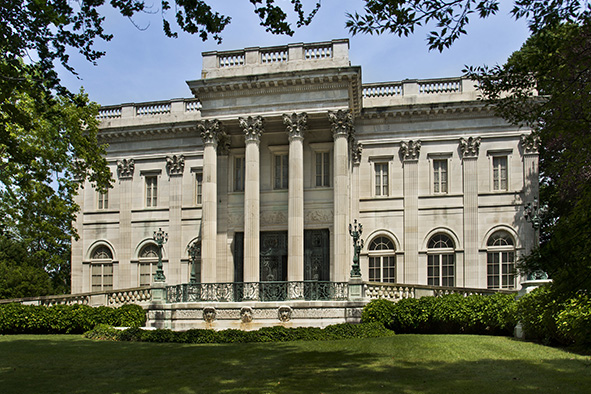
Marble House exterior (Photo: Gavin Ashworth/The Preservation Society of Newport County)
Marble House, Marble Heart
Just three years after William Vanderbilt, the grandson of the railway and steamship tycoon Cornelius Vanderbilt, gifted the $11-million Marble House estate to his wife Alva for her 39th birthday, she divorced him.
It was a bold move to leave your husband in 1895, especially a descendent of one of the wealthiest families in the country. But Alva was the epitome of bold.
The meticulously designed summer cottage echoes her appreciation for power. She awoke each morning to the view of a painting of Athena, the goddess of war and wisdom, on her bedroom ceiling. Many walls were constructed to hold specific masterpieces, including two paintings of French royalty in the dining room. One is of young King Louis XV in the original gilded frame, presumably meant as a gift for another royal court; the other, his curly-black-wig-wearing predecessor, the Sun King, whose insignia of a face crowned in rays of light shines throughout the house. On either side of the entry hangs a rare French tapestry depicting a prominent uprising – the very reason they were saved from destruction during the French Revolution. Telling décor.
That same year, the feminist and vocal advocate for the suffragist movement threw a debutante ball for her eighteen-year-old daughter Consuelo. Unsurprisingly, the Vanderbilts were left off the 500-person guest list. Even more gossip-worthy was the guest of honor – the 9th Duke of Marlborough, Charles Spencer-Churchill.
While I faintly remember the darkly hued courtliness of Consuelo’s French Renaissance style bedroom, what gripped me long after the tour was what I read about her in the basement on my way toward the exit. Trim and gentle-featured, the young beauty of the Gilded Age had been secretly engaged when her mother arranged her marriage to the Duke. The woman-who-always-got-what-she-wanted did not allow her daughter to leave the house until she’d consented. Consuelo admitted in a journal that she’d wept alone in her bedroom on her wedding day. I wondered if every American “Dollar Princess” had done the same.
Before I left the Marble House souvenir shop, though a bit torn, I bought a cloth Christmas ornament shaped as a teacup, outlined in golden thread with “Votes for Women” sewn in blue, a replica of the custom china Alva had designed for the suffragist rallies she held at the Marble House. In 1920 Alva again got what she wanted: women’s suffrage.
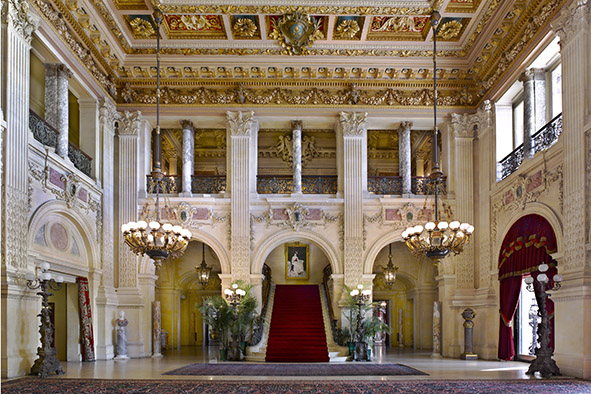
The Breakers Great Hall (Photo: Gavin Ashworth/The Preservation Society of Newport County)
A Legacy Preserved
Before The Elms tour had begun, I’d waited in awe before the double staircase trying to convince myself that the building was once a family’s home and not a museum. A woman mentioned a big, fancy house that everyone loves visiting. She was not referring to the big, fancy house I was currently ogling, but to the Breakers: Cornelius Vanderbilt II’s 138,000-square-foot cottage. The 13-acre property stretches to the historic Cliff Walk, from where locals and tourists can peak over a brush-lined fence at the lawn where raucous parties once competed with the rhythmic crash of waves breaking against the cliff-side.
Before entering the main hall of the Breakers, guests would freshen up in dressing rooms on either side of the entry, where our tour began. Like The Elms, the Breakers was one of the first homes to run on self-generated electricity, created by generators powered by coal-run boilers that servants loaded 24/7 in the basement. Much of the lighting throughout the house ran on electricity as well as gas for backup, in case the fickle new technology misbehaved.
Lit by 900-pound chandeliers, the expansive main hall reflects the design influence of an Italian Renaissance-style palazzo, complete with ornately carved pilasters. Rough Newport winters had made building a truly al fresco experience impossible. Instead, the gilded ceiling appears to open up through a painting of puffy white clouds floating in a powder blue sky.
The Breakers stands apart from the rest of the summer cottages in size and décor, but also in the desire of Cornelius’s wife Alice for a more “subtle” approach in their upstairs living quarters. There is nothing subtle, though, about the rest of the house. When I entered the Music Room, where the family entertained guests with musical performances, I felt at once enveloped in elegance and underdressed. Gilded decorations and paneling embellish the grey walls and ceiling, enhancing the glow given off by crystal wall sconces and chandeliers. No pub signs adorn the walls in the Billiard Room. Vanderbilt preferred marble, alabaster, semi-precious stones, and custom everything, from the mosaic ceiling and floors – each tiny tile placed by hand – to the bronze Tiffany wall sconces whose opalescent glass sparkles whenever graced by sunlight.
But again, what struck me more than the 70 rooms, 2,400-square foot dining room (almost double the size of my entire house) and 27 fireplaces, was the fact that Cornelius had a stroke soon after the house was built. He died four years later in 1899 at the young age of 55. The powerful executive had enjoyed his lavish summer residence in good health for just one summer, during which he, like the other businessmen on the block, probably only made weekend visits after working long hours all week in New York.
It was his daughter Gladys who would later take over the Breakers. In 1948, she rented the first floor to the Preservation Society of Newport County for a dollar a year to run tours and raise funds to preserve more of these Gilded Age gems. The gesture was a gracious one. Even so, Gladys wondered who would actually pay money to walk around her family’s home. To her surprise, 28,000 people visited that first summer. The Preservation Society later bought the residence from her heirs. Like me, I bet the 400,000 visitors each year don’t leave with impressions solely of the décor but the lives of those who lived behind the ornate iron gates.
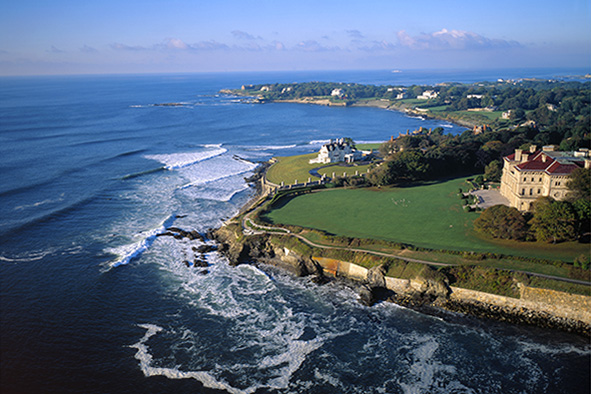
Newport coastline and The Breakers mansion (Photo: Onne van der Wal via Discover Newport)
Further Information:
Visit www.newportmansions.org for more information about tickets, tours, and other historic properties nearby.
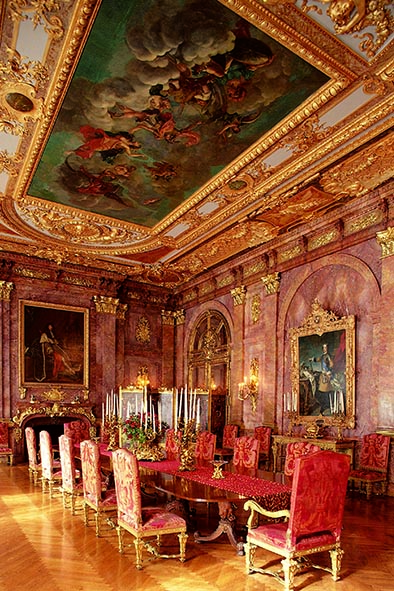
Paintings of the French kings Alva Vanderbilt admired – the grand dining room of Marble House (Photo: The Preservation Society of Newport County)